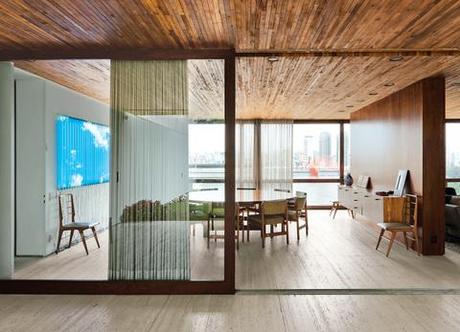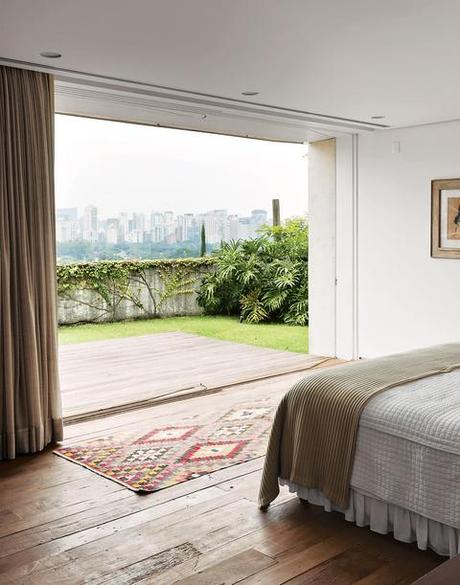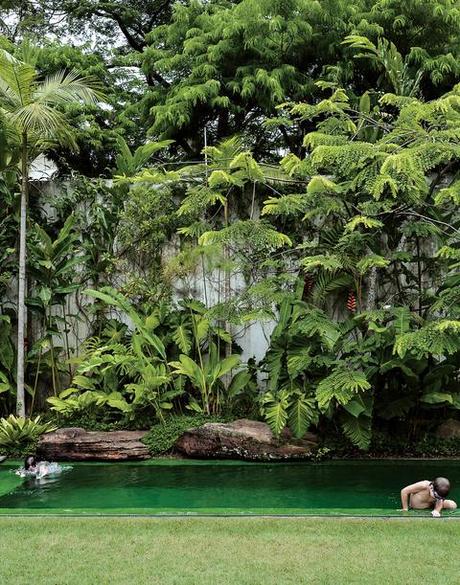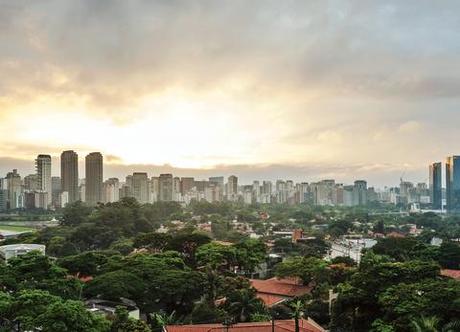
A wooden partition separates the dining room from the living room. The jacaranda table is a vintage find designed by Jorge Zalszupin for L’Atelier. The dining chairs are by the Brazilian designer Sergio Rodrigues and architect Isay Weinfeld designed the sideboard. The fluorescent lamp sculpture on the wall is Luz Natural by Eduardo Coimbra.
As you enter the front gate and push through dense, dripping foliage, you may wonder if you’ve made a wrong turn. Then, through the thick leaves, you catch a reassuring glimpse of a neat garden and, just beyond it, a long, columned terrace. A late-morning downpour seems to have spent itself and at the end of this unexpected patch of jungle, you’re confronted all at once with a staggering view of São Paulo, slashed now with sunshine. The entire scene is framed, as if within a 70mm movie lens, by the Strozenberg family’s long, low-slung, light-filled living room.
“The cinema is without a doubt one of the strongest influences in my life,” says architect Isay Weinfeld, who designed Alan and Ticiana Strozenberg’s home and gardens. And these filmic tendencies are evident even before you reach the Strozenbergs’ front door. Instead of a straight shot down a front walk, Weinfeld leads you on a more complex narrative of unforeseen turns and sudden surprises, as thick tropical foliage postpones, and at times hints at, the big reveal.
Weinfeld has in fact tried his hand at moviemaking. Together with fellow São Paulo architect Marcio Kogan, he codirected the 1988 film Fogo e Paixão (Fire and Passion), a small cult classic in which the madness of São Paulo’s built environment plays a leading role. Weinfeld says his architecture shares cinema’s concern “with light, with rhythm, with suspense, with symmetry and asymmetry,” and he tries to lead people through his buildings “in the same way a filmmaker leads the spectator through a movie.”
Slideshow
Those in a bedroom are by Toque Final.
Appropriately enough, the Strozenbergs’ home recalls one of those high modernist roosts up in the Hollywood Hills—the kind that, in films like The Player and Mulholland Drive, represent L.A. dreams realized. The Strozenberg residence shares with these homes a common architectural DNA, including an open floor plan, floor-to-ceiling windows, an integration of house and garden, and a huge deck with unimpaired vistas across Brazil’s sprawling, car-crazy metropolis.
“From our windows, I can see São Paulo and its constant buzz,” says Ticiana. The serene home’s distance from São Paulo’s ceaseless thrum and miasmic traffic can be a valuable thing, indeed.
In the process of creating this leafy hillside retreat, the Strozenbergs were full partners with Weinfeld, from initial sketches to the final choice of materials.
“I only feel ready to start designing after a great deal of conversation with my clients, listening to their needs, their desires, their expectations,” says Weinfeld.
Slideshow
This focus on his clients’ unique needs is borne out in the wide variety of work Weinfeld has produced in São Paulo. On the one hand, he is responsible for Hotel Fasano (another collaboration with Kogan), whose urbane bars and restaurants are favorite retreats of discerning Paulistanos. On the other, he’s the author of Livraria da Vila, a bookstore whose simple whitewashed spaces provide a rare meditative retreat amid the city’s mad rush.
In the case of the Strozenbergs, Weinfeld was collaborating with design-savvy pros: Ticiana is a graphic designer, and Alan is an advertising wunderkind. And the couple came to the table with two very clear principles: First, they wanted every room to connect with the surrounding gardens. And second, they wanted no decoration for its own sake. Rather, every aspect of the house should be of use in their real, day-to-day lives. No living room reserved for guests. No part of the house roped off except on special occasions.
“We were very clear that we did not want a showroom,” explains Alan. “When you have four kids, it’s hard to maintain showroom conditions anyway.”
Despite its clean design, the house reveals the bustle of family life. In the living room, you might run across a cluster of recently abandoned toys, while in a back hall, a stack of contemporary art lies in wait for the right patch of wall.
Slideshow
To nurture a feeling of conviviality, Weinfeld made the kitchen, living room, dining room, and media room all flow together seamlessly. Wood-paneled bays provide separation without isolation, and all these spaces in turn communicate with a common terrace and garden. “Alan can watch a football game in the media room, Ticiana can entertain guests in the living area, and the kids can be having a snack in the dining area or playing in the garden or pool—all at the same time,” explains Weinfeld.
The Strozenbergs’ insistence on utility extends even to their churrasqueira, or barbecue grill. A sacred element of the Brazilian home, it should, by tradition, be fired by charcoal or wood. But the Strozenbergs opted for an unorthodox gas model. “It’s the only way we knew we were actually going to use it,” laughs Ticiana.
That same desire for functionality encompasses the forms and materials of the house itself, where Weinfeld and his clients have opted to invest in space and light rather than showy surfaces. The travertine floors in the living area have an unassuming matte finish; otherwise, the house consists of glass and recycled wood, arrayed in simple, largely rectilinear forms—from the concrete slab of the roof to the unadorned pillars that hold it aloft.
But in the end, this austere palette serves to enhance the home’s truly luxurious element: proximity to nature and all its potential. “We didn’t want a garden that was sculpted and pruned,” Ticiana tells me. “We wanted something that would grow along with us.”
And so, on a tricky hillside lot in a concrete-bound megacity, Weinfeld and his team have carved out a space where rushing cars give way to thick clusters of palms, bamboo, and fruit-bearing trees, which beckon outside every room.
